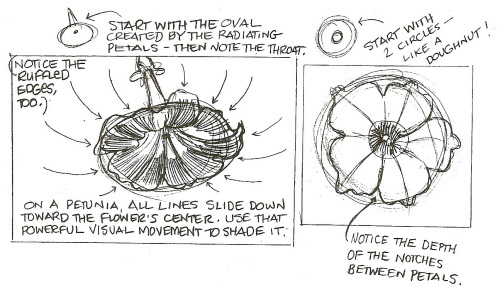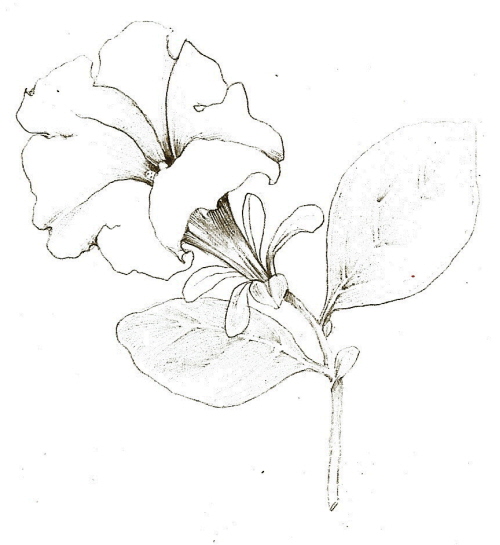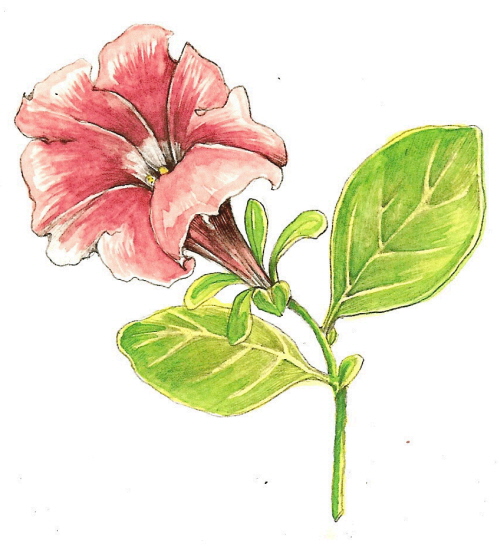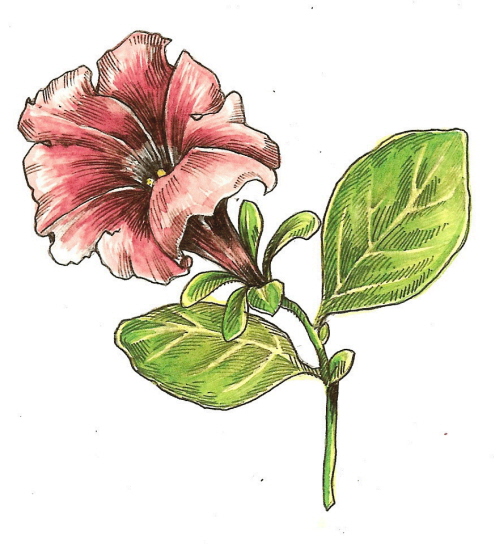In our subtropical climate, most flowers grow better in the fall than during our oppressively hot summer months. An example? Petunias! I have several growing at the corners of the winter garden, blooming abundantly next to the broccoli and shallots. (Watch a step-by-step video of how to draw a petunia here: http://www.youtube.com/watch?v=cYcIPi501es.) Here’s a quick little lesson in capturing this distant relative of the tomato, potato and tobacco…
Start with a simple sketch in pencil…
Using transparent watercolor, cover the leaves, stems and sepals with a layer of the palest color you see on these structures. (Often this will be the yellowish color of the midvein, the large central vein down the center of each leaf.)
Now add a layer of deeper green, being careful not to cover up the pale veins or highlights. Put a first layer of color on the flower itself, leaving the lightest areas uncovered for now.
Wait again for everything to dry, then paint the darker areas of the leaves and stems. Add a deeper layer of color to the flower. Spend some time really looking closely at the landscape of your flower surface. Paint a pale layer of color on the flower’s lightest areas.
For a more graphic effect, you may want to add more pencil as a final touch. Crosshatching with lines (below) adds some drama, but simply shading darker areas with a soft lead pencil works well, too.







You know what? This actually makes sense to me! To the point where I’m tempted to go buy some paper and watercolours and a brush or three and TRY doing something like this. I think first I’ll go with the pencil sketches and see what I can do…you’ve really inspired me because I so adore botanical art and watercolours yet I’ve always maintained I can’t draw…Maybe it’s like photography, learning to see and learning to do things a certain way–and learning to trust a little bit, too.
Val, it’s very generous of you to put something like this up. Who knows how many people will see it and feel like trying their hand at drawing/painting too!
I’m not very good at drawing but I love the way you’ve broken this down into steps – it makes it sound almost within grasp!
I’ve only just found your site and have been having a look at a few more posts – lovely sketches Val!
Gorgeous! The step-by-step instructions are so wonderfully thought out and explained. You make it look so easy and that is the mark of a truly gifted artist.
Val, I’m afraid it’s going to take more than this to make an artist of me. I think just for fun that sometime I will make some drawings and post them on my blog–just so everyone can have a good chuckle in their day.
–Robin (Bumblebee)
Wow, you must have been reading my mind. After seeing your beautiful Butterfly Ginger drawing, I kept saying “How does she do that?” I think I’ll print out your tutorial and try my hand at it this weekend. Thanks for sharing your talents!
Thanks, everyone! I wish you lots of plant-drawing fun.
Val, you’re inspiring and now you have us believing it might just be in us to be able to draw that which we love. I guess we never know until we try! I’ve always wanted to be able to do this. Thank you for the tutorial!
It’s been years since I’ve picked up a drawing pencil but your informative tutorial has inspired me to perhaps give it another try. With snow soon upon us, I can spend the winter drawing the garden of my dreams!
Beautiful drawings! Makes me want to draw and plant, though my garden has finally succumbed to the frost…
Val, I have a brain like mush sometimes…I added your blog to my feed reader, and I just referred to this entry in one of my postings…and realized as I was housecleaning bloomingwriter that I forgot to add a link to your blog in my list! Colour me overworked…it’s there now, under gardening blogs.
I read about your blog at Jodi’s (bloomingwriter). What a great idea this is having an online tutorial. I haven’t picked up a pencil or pastels in years (actually nearly 2 decades) but this has kindled a spark in me … I may see if I still have some of my supplies.
Thank you!
Diane at Sand to Glass
http://sandtoglass.blogspot.com/
http://dogsnaturally.blogspot.com/
This is so thoughtful and generous of you, Val! Thank you for sharing your plant-drawing technique. Now it might not be so daunting after all to draw more diverse plant-life than just my usual sunflowers or tulips!
Hmmmm….maybe I could…..! I’ll be back!
Your blog is great! I love it. Very inspiring.
Very nice site. Did you do the web site yourself?
Thanks, audreyanna. I just customized one of the WordPress templates with my own illustrations. They make it easy.
i really like this method. nowonwards i apply for my students.
Thank you so much for the tutorial. As soon as it stops raining I will go out and try to draw and paint my Petunias.
Is it alright if I put you on my bloglist?
Pingback: Watercolor Tutorial Links — Craft Stew
thank you for this post!!! I got a watercolor moleskine for Christmas and haven’t been sure how to start (new to moleskines and watercolor-I have used the pencils to draw with). I’m going to start out by trying this:)
thanks again
Trish
Val .. I’m sure I have visited before and made note of how pretty your drawings are .. now that is a little “Twilight Zone” moment for me ? LOL
I’d love to follow these tutorials .. the thought of being able to sketch parts of my garden and plants is rather thrilling ! Thank you !
Joy : )
Great tutorial! I’ve been meaning to get into botanical art, and with summer months approaching, I just might! 🙂
This is a real help. I love to draw, and love to garden and photograph flowers and plants – have always wanted to learn botanical watercoloring. Is there is a local class offered?
i think i may have found heaven. I am in the process of finding a new passion due to a fairly serious injury… I remember drawing as a child and this tutorial is excellent. I can’t wait to give it a try. My flowers are what make me smile. My oldest just told me about a new art class offered at the art center. I think I will chicken out, but this, I can try without the fear of public failure… Thank you!
Pingback: Learn to Draw at The Illustrated Garden « ArtPlantae Today
Pingback: Step-by-Step Botanical Drawing Techniques in Alabama « ArtPlantae Today
Was so glad to be notified of the Blog Thread re inspiration. Happy New Year! What was missing in 2009? That I didn’t get into your classes – hoping to be able to make it soon, now that I am settled into the new job and new apartment. My inspiration seems to come when I am resting and meditating on the various challenges of the day – something will pop into my head, and the need to pursue it takes over.
Hello,
You are so very talented, a superb botanical illustrator!
~ Gabriela ~
Pingback: Visit the Illustrated Garden on Facebook « ArtPlantae Today
It does amaze me that while the great botanical artists of yesteryear were all males. the botanical artists of today are all females. I continue to do my own thing here in Northwestern Arizona, though it would be good to find that other men are interested in botanical art.
My “Wave” petunia made it through high heat in the unvented greenhouse during the summer, and freezing temps the following winter. It “trailed” for 9 feet, up over the fence, and down to the lower level. I have a picture if I can figure out how to add it here. Will send to Val in an email.
Pingback: Botanical Art at New Orleans Botanical Garden « ArtPlantae Today
You are truly an answer to prayer! I am taking my first watercolor class and am really struggling. Your step by step instructions are magnificent, the U tube demo for sketching is fabulous, you have encouraged me when I have felt so lost and overwhelmed. Thank you, thank you, thank you!!!
🙂
Pingback: Draw Birds, Nests & Eggs at the Illustrated Garden « ArtPlantae Today
Pingback: Fall Classes at The Illustrated Garden Include Drawing, Painting & Printmaking « ArtPlantae Today
Pingback: Paint the Kitchen Garden, Holiday Botanicals Too « ArtPlantae Today
Superb Val?….
awesome illustrator! i like the way to painting color on illustration thank you so much!
wow!awesome!
Pingback: Nature Drawing Classes in Alabama, Mississippi and Florida « ArtPlantae Today
oh! Thank you so much for breaking this down! I’m such a huge fan of watercolors but, I’m also a beginner and really appreciate this tutorial. It really explains the process in a way that I hadn’t understood before.
Thanks, again!
Jen
Dear Jen,
Thank you for your nice comment. I am so glad that you enjoyed the petunia tutorial — I posted a 15-minute petunia-drawing lesson on YouTube last year, which will give you a little more information than the blog. Here is the link to the lesson. Happy drawing!
Peace,
Val
Oh, perfect! Thanks for the link! I’m off to watch!
Jen 🙂
Кого заинтересовала информация могут прокомментировать мои рисунки
в моём блоге ниже указоном
Reblogged this on Cool People for Hire and commented:
I’m going to learn how to paint like this.
Pingback: A Different Kind of Botanical Art Class « ArtPlantae Today
Pingback: Val Webb´s studio blog | By Botany
Pingback: Study & Draw Carnivorous Plants at Splinter Hill Bog « ArtPlantae Today
Amazing piece of pencil drawings, love to see them 🙂
If some one wishes to be updated with newest technologies then he must be pay a visit this site and be up to date daily.
I’m adding my voice to the many who thank you for this tutorial!
Pingback: Looking for more than your typical botanical drawing course? | ArtPlantae Today
VERY GOOD LOVE IT !!!